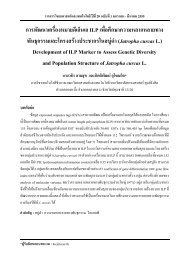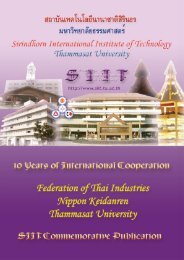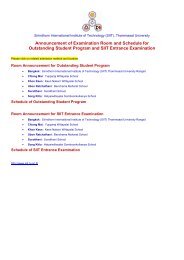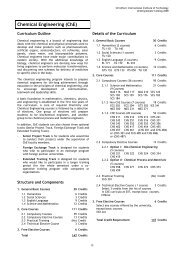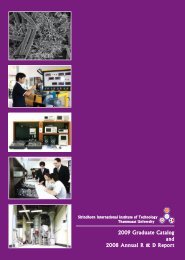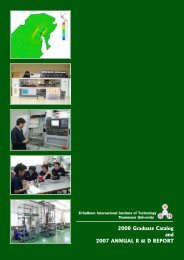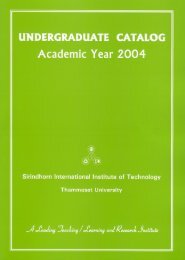2005 Graduate Catalog and 2004 Annual R & D Report - Sirindhorn ...
2005 Graduate Catalog and 2004 Annual R & D Report - Sirindhorn ...
2005 Graduate Catalog and 2004 Annual R & D Report - Sirindhorn ...
- No tags were found...
You also want an ePaper? Increase the reach of your titles
YUMPU automatically turns print PDFs into web optimized ePapers that Google loves.
<strong>2005</strong> <strong>Graduate</strong> <strong>Catalog</strong> <strong>and</strong> <strong>2004</strong> <strong>Annual</strong> R & D <strong>Report</strong><br />
<strong>Sirindhorn</strong> International Institute of Technology (SIIT)<br />
School of Bio-Chemical Engineering <strong>and</strong> Technology<br />
Faculty Members <strong>and</strong> Research Interests, <strong>2005</strong><br />
Dr. Alice Sharp<br />
Assistant Professor<br />
B.Sc. in Biology, Chiang Mai University, Thail<strong>and</strong><br />
M.Sc. in Environmental Risk Assessment, Chiang Mai University, Thail<strong>and</strong><br />
M.Sc. in Natural Resource Management, Hiroshima University, Japan<br />
Ph.D. in Natural Resource Management, Hiroshima University, Japan<br />
Areas of Specialization: Community based natural resource management, Environmental Impact Assessment,<br />
Pollution monitoring.<br />
Research Interests:<br />
Community Based Environmental Protection<br />
(CBEP)<br />
CBEP is a new approach to environmental protection.<br />
Traditionally, environmental protection programs have<br />
focused on the comm<strong>and</strong> <strong>and</strong> control approach,<br />
which have been very effective at reducing point<br />
source pollution <strong>and</strong> improving environmental quality.<br />
However, some environmental problems, such as<br />
non-point source pollution are less amenable to these<br />
programs. CBEP will supplement <strong>and</strong> complement<br />
the traditional environmental protection approach by<br />
focusing on the health of an ecosystem <strong>and</strong> the<br />
behavior of humans that live in the ecosystem’s<br />
boundaries. This study is aiming to 1) comprehensively<br />
identify local environmental concerns, 2) set<br />
priorities <strong>and</strong> goals that reflect overall community<br />
concerns, <strong>and</strong> 3) develop comprehensive, long-term<br />
solution to environmental problems.<br />
Products Life-Cycle Assessment (LCA)<br />
Life-cycle assessment (LCA) is used to quantify the<br />
environmental inputs <strong>and</strong> outputs of a product or<br />
process, from the mining of raw materials, through<br />
production, distribution, use <strong>and</strong> reuse or recycling, to<br />
final disposal. There are two main stages of LCA:<br />
inventory analysis <strong>and</strong> impact assessment. Inventory<br />
analysis involves the quantification of environmental<br />
inputs <strong>and</strong> outputs throughout a product or process’s<br />
lifetime. The inventory analysis is aiming to identify a<br />
list of pollutants that may have an impact on the<br />
environment. The purpose of the impact assessment<br />
is to aggregate <strong>and</strong> evaluate the potential<br />
environmental impacts identified in the inventory. This<br />
study will be focusing on particular kinds of waste<br />
which have high potential to be a major environmental<br />
problem in the future, mobile phone <strong>and</strong> its batteries,<br />
as an example in order to develop waste<br />
management plan <strong>and</strong> minimize the amount of waste<br />
before h<strong>and</strong>.<br />
Waste Management<br />
Waste management is one of the major long-term<br />
problems in our society. Cost-effective, environmentally<br />
sound management of wastes continues to<br />
be an unstable issue, the solution of which must<br />
integrate science, technology, individual awareness,<br />
<strong>and</strong> policy. Waste management begins with<br />
underst<strong>and</strong>ing the complete <strong>and</strong> detailed physical,<br />
chemical, <strong>and</strong> biological characteristics of the waste<br />
in question. This underst<strong>and</strong>ing is crucial to<br />
successful utilization or environmentally sound<br />
disposal measures. Additionally, waste management<br />
enables us to predict what is in a material, how much<br />
is there, how it may leach out, <strong>and</strong> how it will<br />
ultimately impact the environment.<br />
Dr. Pisanu Toochinda<br />
Lecturer<br />
B.Sc. in Chemistry, Mahidol University, Bangkok, Thail<strong>and</strong><br />
M.Sc. in Chemical Engineering, The University of Akron, Akron OH, USA<br />
Ph.D. in Chemical Engineering, The University of Akron, Akron OH, USA<br />
Areas of Specialization: Photo-catalytic synthesis of hydrocarbons from CO 2 /H 2 O, Gas-solid reactor design,<br />
Heterogeneous Catalysis, Nano-materials / zeolite syntheses, Bio-molecular imprinted material.<br />
Research Interests:<br />
Carbamate <strong>and</strong> Isocyanate Synthesis from the<br />
Gas-Solid Catalytic Oxidative Carbonylation<br />
Reactions<br />
Development of environmentally benign synthesis<br />
processes that eliminate toxic feedstocks, combine<br />
process steps, <strong>and</strong> result in a net reduction of<br />
pollutants <strong>and</strong> energy use rests on, to a great extent,<br />
innovations in reactor design, reaction pathways, <strong>and</strong><br />
catalysis.<br />
Carbonylation reaction serves as a new route for nonphosgene<br />
processes in the production of carbamate<br />
<strong>and</strong> isocyanate at mild conditions for the replacement<br />
of highly toxic phosgene in the synthesis of carbamate<br />
<strong>and</strong> isocyanate. Combining the gas-solid reactor<br />
system <strong>and</strong> the Pd-based catalysts could provide<br />
promising alternatives for carbamate <strong>and</strong> isocyanate<br />
synthesis in the industry.<br />
13




